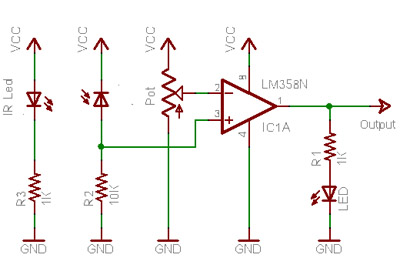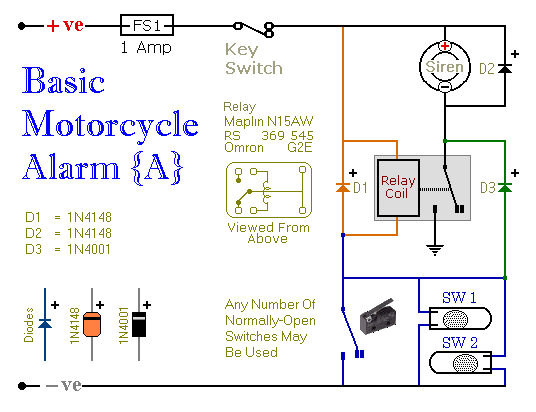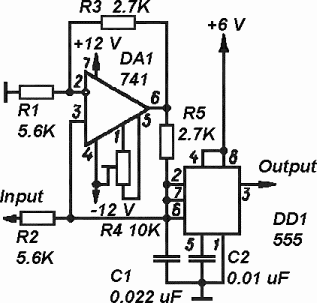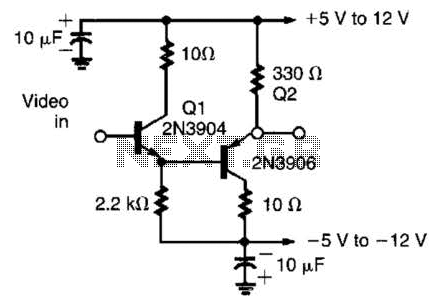
simple line follower

When no light is incident on the diode, it exhibits high impedance (resistance). In contrast, when light strikes the diode, its resistance decreases significantly, approaching a short circuit condition. In the absence of any object in front of the sensor, such as in a black body or space, the diode will not receive light and will behave like an open circuit. Consequently, the output voltage will be nearly 5V, causing the motor to move forward. When light is detected, the motor will stop.
The described circuit involves a light-sensitive diode, commonly known as a photodiode, that plays a crucial role in controlling the operation of a motor based on light exposure. In this configuration, the photodiode is connected in such a way that it influences a relay or transistor switch that drives the motor.
Under low-light or no-light conditions, the photodiode maintains a high resistance, resulting in minimal current flow. This high impedance state allows a voltage close to 5V to appear at the output, which can be used to energize a control circuit, leading to the motor moving forward. The motor's forward motion can be facilitated by a power supply connected to the motor driver circuit, which is activated by the output signal from the photodiode.
When the photodiode is exposed to light, its resistance drops significantly, effectively creating a condition similar to a short circuit. This change allows a larger current to flow through the circuit, which can trigger the relay or transistor to turn off the motor. The abrupt change in state from high resistance to low resistance results in the motor stopping, demonstrating the photodiode's ability to act as a light-sensitive switch.
In summary, this circuit exemplifies a simple yet effective method of controlling motor operation based on light levels, utilizing the inherent properties of a photodiode to switch between high and low impedance states, thereby influencing the motor's activity.If there is no light falling on the diode it will exert a high impedance(resistance). if light falls on the diode resistance of the diode willdecreased. (almost short circuit) in case of a black body or space(no objectin front of sensor) thenno light falls on the diode so it will act like a open circuit. so voltage at output will be almost equal to "5V" MOTOR GOES FORWARD MOTOR WILL BESTOPPED 🔗 External reference
The described circuit involves a light-sensitive diode, commonly known as a photodiode, that plays a crucial role in controlling the operation of a motor based on light exposure. In this configuration, the photodiode is connected in such a way that it influences a relay or transistor switch that drives the motor.
Under low-light or no-light conditions, the photodiode maintains a high resistance, resulting in minimal current flow. This high impedance state allows a voltage close to 5V to appear at the output, which can be used to energize a control circuit, leading to the motor moving forward. The motor's forward motion can be facilitated by a power supply connected to the motor driver circuit, which is activated by the output signal from the photodiode.
When the photodiode is exposed to light, its resistance drops significantly, effectively creating a condition similar to a short circuit. This change allows a larger current to flow through the circuit, which can trigger the relay or transistor to turn off the motor. The abrupt change in state from high resistance to low resistance results in the motor stopping, demonstrating the photodiode's ability to act as a light-sensitive switch.
In summary, this circuit exemplifies a simple yet effective method of controlling motor operation based on light levels, utilizing the inherent properties of a photodiode to switch between high and low impedance states, thereby influencing the motor's activity.If there is no light falling on the diode it will exert a high impedance(resistance). if light falls on the diode resistance of the diode willdecreased. (almost short circuit) in case of a black body or space(no objectin front of sensor) thenno light falls on the diode so it will act like a open circuit. so voltage at output will be almost equal to "5V" MOTOR GOES FORWARD MOTOR WILL BESTOPPED 🔗 External reference





